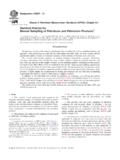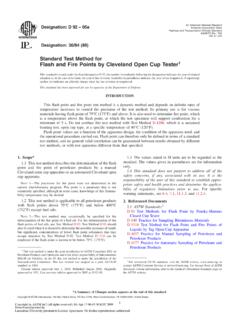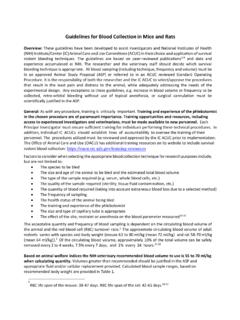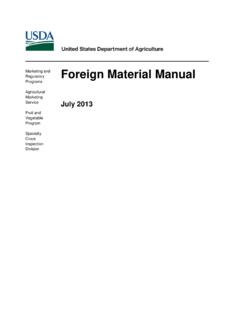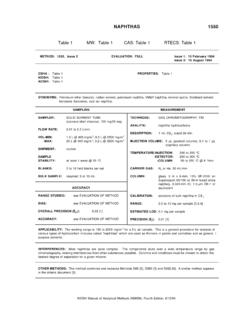Transcription of U.S. DEPARTMENT OF LABOR Occupational Safety and Health ...
1 Abstract - 1 DEPARTMENT OF LABOR Occupational Safety and Health Administration DIRECTIVE NUMBER: TED-01-00-015 EFFECTIVE DATE: 02/10/2020 SUBJECT: OSHA Technical Manual Section IV, Chapter 6, Combustible Dusts ABSTRACT Purpose: This notice adds technical information specific to combustible dusts to the OSHA Technical Manual (OTM). Scope: OSHA-wide References: 29 CFR , Hazardous (Classified) Locations. Combustible Dust National Emphasis Program, OSHA Directive CPL 03-00-008. NFPA 652-2019: Standard on the Fundamentals of Combustible Dust. Cancellations: None State Impact: None. For State reference only.
2 Action Offices: Area Offices Originating Office: Salt Lake Technical Center/ Health Response Team Contact: Salt Lake Technical Center/ Health Response Team 8660 South Sandy Parkway Sandy, UT 84070 801-233-4900 By and Under the Authority of Loren Sweatt Principal Deputy Assistant Secretary of LABOR Abstract - 2 Executive Summary This chapter (Section IV ( Safety Hazards), Chapter 6), provides technical information for Compliance Safety and Health Officers (CSHOs) to evaluate combustible dust hazards and abatement methods. The content is based on current industry practices, research publications, OSHA standards, and consensus standards.
3 The chapter is divided into fourteen main sections and includes seventeen appendices. Significant Changes This is a new OTM Chapter, therefore, there are no significant changes. This Page Intentionally Left Blank 1 OSHA Technical Manual (OTM) Combustible Dusts Table of Contents I. Introduction II. Combustible Dust Characteristics III. Combustible Dust Hazards IV. Common Signs that a Combustible Dust Hazard is Present V. Scope and Applicability of OSHA Standards Regarding Combustible Dusts VI. Scope and Applicability of Notable Industry Combustible Dust Standards and Guidance VII. On-Site Inspection Initial Considerations VIII.
4 Housekeeping Considerations IX. Combustible Dust Equipment Considerations X. Electrical (Hazard) Class II Considerations XI. Determining Tests to Request from the SLTC Laboratory XII. Packaging and Shipping Samples to the SLTC XIII. Combustible Dust Hazard Analyses XIV. References and Standards List of Appendices Appendix A Combustible Dust Case Studies and Lessons Learned Appendix B Combustible Dust Inspection Common Structure and Guidance Appendix C Common Inspection Questions Appendix D Inspection Questions for Dust Collection, and for Deflagration/Explosion Prevention and Protection Systems Appendix E Low-MIE Combustible Dusts Appendix F Combustible Dusts with Other Hazards Appendix G Procedure for Safe sampling of Most Combustible Dusts Appendix H Procedures for Safe sampling of Low-MIE Combustible Dusts a.
5 Introduction b. Low-MIE Hazard Awareness c. Required PPE for sampling Low-MIE Dusts d. Required sampling Tools for Low-MIE Dusts e. sampling Low-MIE Dusts from Metal Collection Drums f. sampling Low-MIE Dusts from Horizontal or Vertical Surfaces g. sampling Low-MIE Dusts from Inside Equipment such as Dust Collectors, Ductwork, and Size-Reducing Equipment h. sampling Low-MIE Dusts from Non-Metallic or Non-Conductive Containers such as Plastic Drums and Fiberboard Drums i. sampling Low-MIE Dusts from Other Containers or Equipment Not Covered Above 2 Appendix I Procedures for Safe sampling of Combustible Metal Dusts (Beyond Low-MIE) Appendix J SLTC Laboratory Tests Appendix K ASTM Test Methods Appendix L Typical Combustible Dust Generation Systems and Equipment Appendix M Typical Combustible Dust Collection Systems and Equipment Appendix N Typical Combustible Dust Explosion Prevention and Protection Technologies Appendix O Typical Combustible Dust Deflagration Propagation Protection (Isolation)
6 Technologies Appendix P Typical Other Prevention and Protection Technologies Appendix Q Combustible Dust Electrical Classification and Controls 3 I. Introduction This chapter provides technical information to help OSHA Compliance Safety and Health Officers (CSHOs) inspect and investigate workplaces where combustible dust is present. This chapter provides only supportive information and shall not take precedence over the Combustible Dust National Emphasis Program (hereinafter NEP) or other enforcement-related documents. The NEP is the primary combustible dust inspection document. CSHOs should read and become familiar with the NEP before referring to this OTM chapter.
7 Combustible dust inspections can be complicated. CSHOs should complete specific combustible dust training before performing these inspections. Working with other trained and experienced CSHOs and staff may be valuable for CSHOs without experience conducting combustible dust inspections. CSHOs should recognize Combustible Dust Characteristics and Combustible Dust Hazards before beginning an inspection. Combustible dusts found at different facilities, or at different locations within the same facility, are seldom the same. The size of the dust particles, alone, can change the dust s characteristics enough to change the type and magnitude of the combustion hazard.
8 CSHOs should also recognize the Common Signs that a Combustible Dust Hazard is Present and should determine how to safely conduct the inspection before proceeding (see On-Site Inspection Initial Considerations). In many cases, potentially combustible dusts may be present in various forms in different areas of a facility, or in various locations within equipment (see Appendices L through P for examples of typical dust-related process equipment). All of these factors make combustible dust inspections and investigations unique to each facility in both number and complexity of hazards. Some OSHA standards contain provisions applicable to combustible dusts.
9 See Scope and Applicability of OSHA Standards Regarding Combustible Dusts. Where warranted, and when no OSHA standards apply, the general duty clause should be considered to address recognized combustible dust hazards. This requires that CSHOs know and follow the requirements under the general duty clause to gather adequate evidence to support inspection findings (see the NEP and OSHA Field Operations Manual). Industry standards contain provisions that apply to many types of combustible dusts and may be referenced in the absence of OSHA standards as evidence of hazard recognition in the industry and the existence of feasible abatement measures.
10 See Scope and Applicability of Notable Industry Combustible Dust Standards and Guidance. Combustible dust inspections should focus on Combustible Dust Hazards in three primary areas: Hazards associated with housekeeping (See Housekeeping Considerations) 4 Hazards associated with equipment ( See Combustible Dust Equipment Considerations) Hazards associated with electrical equipment in classified locations (See Electrical (Hazard) Class II Considerations) Each of these inspections are normally done together but can also be done separately. However, when facilities include dust collectors, CSHOs should perform inspections of the dust collectors and systems, as over half of all combustible dust explosions occur within dust collectors.










